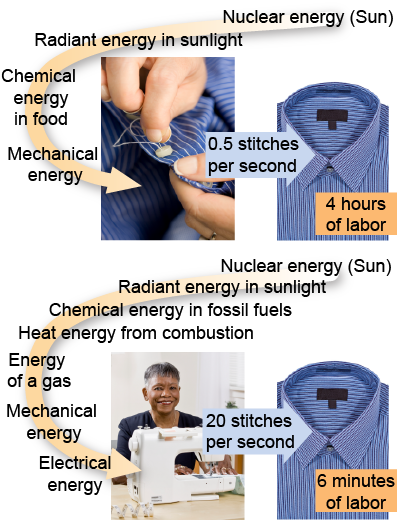|
All processes in both nature and technology occur through a continuous flow of energy. Scientists learn a great deal by following the flow and transformation of energy. A system can transform its available energy into speed, height, heat, or even mass. The system must have energy to begin with, and any energy transformed into one form depletes other forms by the same amount. This section examines how energy is transformed through technologies such as the photovoltaic cell, which converts radiant energy into electrical energy. 
|
Energy flow diagrams
|
Consider the sewing machine, one of the most revolutionary devices ever invented. Clothing is a basic human need and prior to the sewing machine all clothes were stitched together by hand. Hand sewing requires considerable skill and takes a long time. A single shirt might take several hours to sew by hand. The same shirt can be sewn on a machine in six minutes with perfect, uniform stitches. 
| 
|
Sewing requires mechanical work—forcing a needle through cloth. To estimate the energy involved, assume a weight of 20 N for your forearm and hand. Your hand moves about 40 cm to make a stitch so each stitch represents about 8 J of muscle work. If you average a stitch every 2 s that is an energy flow of 4 J/s. That muscular energy comes from food which derives ultimately from sunlight, so the flow of energy through your muscles traces its way back to nuclear energy in the sun. 
|
Transforming energy from one form to another is depicted in an energy flow diagram or described as an energy chain. The energy used by the sewing machine comes from an electric motor that converts electrical energy to mechanical energy. Two-thirds of U.S. electricity is generated from burning coal or natural gas. The fossil fuel itself came from decaying plants. Burning fuel transforms chemical energy into thermal energy, and the heat produced is used to boil water into steam. The steam turns a turbine that converts the thermodynamic energy of the gas into mechanical energy; the turbine drives a generator to produce electrical energy. The electrical energy we use is ultimately derived from nuclear energy in the Sun, transported to the Earth as radiant energy, accumulated by plants over millions of years, then stored in fossil fuels. 
 |
How much total energy has been used up to the point of actually sewing together a shirt? This is not an idle question. Buying a shirt is using energy because it takes energy to farm the cotton, weave it into cloth, ship the cloth to a factory, produce the shirt, and then ship it to the store. We humans are learning that the energy content in what we buy must ultimately come from some source, often fossil fuels. One of the major goals of engineering and technology today is to apply science to reduce the energy content of goods we produce and use. 
|
Where does the vast majority of Earth’s energy originate? - the Moon
- the Earth’s core
- the atmosphere
- the Sun
 |
The correct answer is d, the Sun. Most of Earth’s energy originates in the nuclear fusion inside the Sun. That energy then gets transported across space via electromagnetic waves and changed into the different types of energy we use every day. 
|

